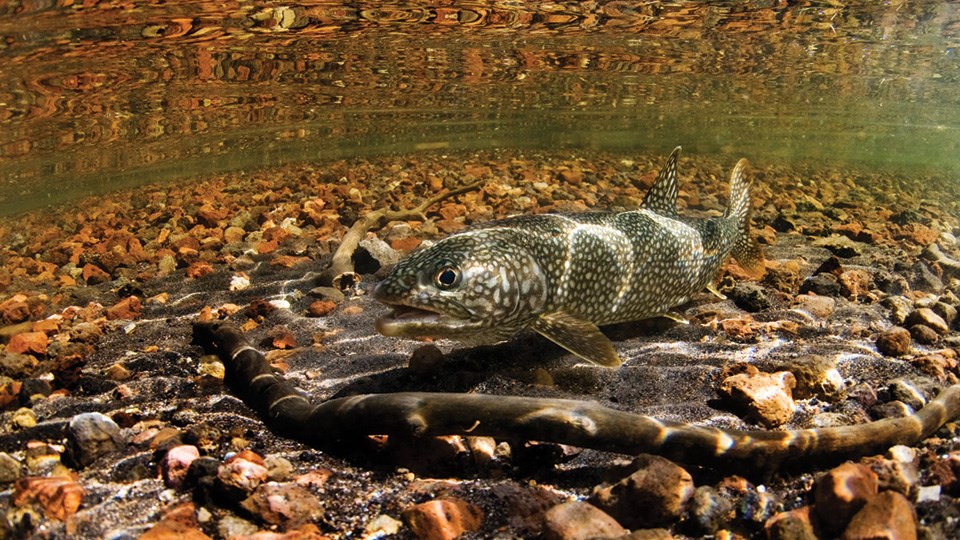
By Mike Koshmrl, WyoFile.com
YELLOWSTONE LAKE—By mid-October there was little sign of life at Bridge Bay Marina on the northwest corner of Yellowstone Lake. The fleet of fishing boats had been trailered away, the parking lot empty, the bathrooms locked. But nobody had wiped the whiteboard clean.
A marked-up map just outside the staging area for an immense ecosystem restoration project showed where crews set nets. A tally left on the board from early September counted 204,300 slain exotic lake trout from the summer. By the time Yellowstone National Park’s lead fisheries biologist, Todd Koel, talked to WyoFile a month after the last whiteboard update, the cull had jumped by an additional 80,000 fish.
Another year, another big haul of exotic char netted from 136-square-mile Yellowstone Lake.
This was not the game plan.
Back in 2012, Yellowstone officials announced that after a decade of underestimating the nonnative fish, also known as mackinaw — which proliferated at the expense of native cutthroat trout — they’d finally scaled up their netting operations to a degree that would meaningfully drive down the lake trout population. By stringing up to 6,000 miles of gillnet throughout the big lake over the ice-free months, Koel and his crews sought to catch and kill half of all the lake trout dwelling in Yellowstone Lake every single year.
At an expense of $2-3 million a year, they’ve succeeded on some fronts: More than 80% of mature, fish-eating lake trout have been eliminated, and there are anecdotal reports of some spawning cutthroat trout staging a comeback. The end goal was always causing a population crash. Models suggested a collapse would happen and the National Park Service narrative was that, after a sharp decline, Yellowstone could back off netting and turn to a less intensive and costly “population maintenance” method, like killing mackinaw eggs in spawning bed cobbles.
But numbers of young lake trout have stayed high even after 11 straight summers of intensive netting. Koel now questions if that precipitous crash will ever come.
“Into the foreseeable future, gillnetting is always going to be the cornerstone of suppression,” Koel said. “There is a component of it that will become more long-term operational, just like we maintain roads and do other maintenance.”
Netting, he said, is “just going to be a part of” Yellowstone.
It’s not entirely settled how lake trout arrived in Yellowstone Lake, but the most accepted theory is that an angler caught some in nearby Lewis Lake, kept them alive in a livewell or bucket and drove down the highway to release them. At the time of lake trout’s 1994 discovery, Yellowstone Superintendent Bob Barbee called it “an appalling act of environmental vandalism.”
Koel has since posed an alternative theory: lake trout washed out of Jackson Lake and swam to Yellowstone Lake on their own, heading up Pacific Creek and down Atlantic Creek by crossing over the Continental Divide at the “Parting of the Waters.”
Regardless of how they got there, the fish-eating char from the Great Lakes and Canada thrived. Within a couple decades, by 2012, there were nearly a million of them, according to Koel. Before lake trout, Yellowstone Lake was arguably the flagship cutthroat trout fishery on planet Earth, but as predation from the larger piscivore ramped up, the native trout population plummeted. The resulting story of ecological collapse is one for the history books: Researchers even drew lines from spawning cutthroats’ absence in Yellowstone Lake tributaries to higher grizzly bear predation on elk calves.
Yellowstone started taking the invasive trout more seriously and ramped up its killing program upon a change of administration. The shift came in 2011, when Dan Wenk replaced retiring Suzanne Lewis as superintendent.
“Dan Wenk said, ‘This is not going to happen, we’re not going to have this environmental disaster on my watch,’’” recalled Cody resident Dave Sweet, a Trout Unlimited volunteer who’s been a longtime spokesman and fundraiser for the Yellowstone Lake cutthroat restoration program.
Under the new regime Yellowstone and its nongovernmental partners started sinking millions of dollars annually into its netting program. With increased resources and effort came increased catches, and soon a fleet of vessels using commercial fishing equipment were catching several hundred thousand of the invading salmonids every year. Until this point, there was annual netting — some 500,000 were killed in total from 2000 to 2010 — but it was limited and focused on juveniles around known spawning grounds on the western shorelines.
Those early netting efforts essentially amounted to “fish farming” that had no effect on the population, said Mike Hansen, a retired fisheries professor who sits on a scientific review panel guiding Yellowstone Lake management.
“I said, ‘Look, you guys need some adult help,’” Hansen said. “You need professionals, guys who learned how to fish in the Great Lakes where they destroyed lake trout populations.”
The Park Service acted on the guidance. Starting in 2012, Yellowstone began contracting with a Wisconsin-based commercial fishing outfit, the Hickey Brothers, whose boats are still slaying lake trout in northwest Wyoming a decade later. Nowadays, a crew of 20 to 30 people operate a fleet of six gillnetting vessels that strategically fish Yellowstone Lake daily from ice-off to mid-October, Koel said.
“We have 40 to 50 miles of net in the lake every day,” he said. “If you were to tie all the net lengths they set together from throughout the entire field season, it’s basically 6,000 miles of net. Enough net to stretch from Yellowstone to Italy.”
That’s a lot of gear in the water of a “tiny lake,” by Hansen’s standards.
“There’s no place to hide,” he said.
Hickey Brothers and Park Service boats halted the population increase, then slowly reduced it. From 2012 to 2021 they netted, killed and sunk more than 3 million lakers — six times greater than the prior decade’s take. Mackinaw now seldom survive past age 5 or so, Koel said, because they’re caught and killed before they get the chance. The difficulty in collapsing the population has come from impressive survival of the fish that don’t get caught.
“Those guys [lake trout] are going to fight back with everything they’ve got, and that’s what they’re doing,” said retired U.S. Geological Survey fisheries biologist Bob Gresswell, who chairs the review panel. “The less adults, the higher the survival.”
Researchers have examined this population response in depth. John Syslo, a National Oceanic and Atmospheric Administration research fisheries biologist, published on it in the Canadian Journal of Fisheries and Aquatic Sciences. He found that Yellowstone Lake mackinaw survive to breeding age at rates four to six times greater than in their native range. An alternative hypothesis explaining lake trout resilience, he wrote, is that early population models underestimated the abundance of larger, older lake trout.
Yellowstone’s goal has been to reduce the population of lake trout down to 127,000 fish. In recent years, the netting boats are still catching in the realm of 300,000 fish annually.
Gresswell, Hansen and the rest of the science panel predict it will take seven more years of netting at the current level to have a 90% chance of meeting the lake trout goal. Yellowstone could up its netting intensity by around 30% and get there sooner — by 2026 — the scientific panel found, but Koel says that’s not practical.
“We’ve maxed out our capacity for boats and docks and housing for staff,” he said. “We don’t really have an ability to increase beyond where we’re at right now.”
Koel likens Yellowstone Lake’s slowly diminishing lake trout population to an airliner easing onto a landing strip.
“It’s not going to, all of the sudden, fall out of the sky and crash,” he said. “That was the way we thought about it early on — that we’re going to crash the population — but that’s not how it works.”
Hansen is more hopeful. Give it time, he said.
“The Park Service has been wringing its hands over the fact that the juvenile fish are still hanging on,” he said. “As you drive the adults down, conditions for the survival of the babies actually improves, but the recruitment we’re seeing cannot be sustained. If you kill all the adults, then you won’t have any babies — that’s the theory of a crash.”
The unknown, he contended, is how low the crash goes and what intensity of netting is required to keep lake trout at trace levels. When the Idaho Department of Fish and Game went after nonnative lake trout in Lake Pend Oreille, they were successfully able to crash the population via netting, reducing it by 84%. Hansen has researched this Idaho Panhandle fishery and his modeling suggests that the state agency could reel back its netting effort by 76-86% and still “keep the population in a stranglehold.”
But Yellowstone Lake is larger and more complex. There’s already been an order of magnitude more lake trout caught and killed in Yellowstone than in Lake Pend Oreille, and Yellowstone Lake is a “better lake” for juvenile survival, Hansen said.
Even if Yellowstone Lake’s 127,000-fish goal were achieved, the science panel’s most recent modeling suggests the Park Service could only cut back on netting by 21-26% from the current level of effort in order to maintain low numbers.
That could mean a multimillion-dollar expense saddling 150-year-old Yellowstone for perpetuity. All told, the park is sinking between $2.8-3 million into its Yellowstone Lake program annually, Koel said, though that figure encompasses research not related to netting.
There are three big pots buoying the effort. Around $1 million of netting revenue a year is generated from the sale of Yellowstone fishing licenses, which recently saw a major price hike explicitly to fund lake trout netting. Another smaller chunk of the annual expense is covered by gate fees, Koel said.
The park’s nonprofit partner, Yellowstone Forever, has also contributed around $1 million a year. The organization’s staff did not respond to WyoFile’s request for an interview, but Sweet, with Trout Unlimited, said that fundraising for interminable lake maintenance has become a “tougher sell” to donors than a one-time project.
“It’s a harder story when you have to say, ‘Hey, look, a crash doesn’t mean it’s the end,’” Sweet said. “You can only go out there and ask donors for a million bucks a year for so long.”
Yellowstone has about emptied its quiver in the effort to find an effective suppression complement to netting. Most of those efforts have targeted lake trout in their earliest life stage: as embryos in eggs. Spawning bed sites cover just .03% of the lake surface, so the theory is that hitting an entire concentrated age class of fish in these relatively small areas could have an outsized effect.
To kill off eggs, researchers have toyed with using electricity, suction-dredging, sediment and even lake trout carcasses — both whole and ground up. The latter method worked because of decay: Rotting fish matter stripped the water of oxygen, suffocating the eggs. Perhaps the most promising technique debuted to date is a trial of an airborne application of custom-made soy pellets, flung from a seed spreader dangling from a helicopter.
Although egg mortality at Yellowstone Lake test plots has approached 100%, Gresswell, on the science panel, said these methods are not proven.
“We know it kills fish, but is it having a population effect?” he said. “I’ve not seen any data to suggest that it is successful or isn’t successful.”
Another solution the future might deliver is using “super male” lake trout in Yellowstone Lake, Gresswell said. These YY chromosome fish have been exposed to hormones and selectively bred so that they produce almost exclusively male offspring. While there’s promise that the technique can eradicate non-native populations — the Wyoming Game and Fish Department is testing it on brook trout in a small stream south of Jackson — the prospect of YY fish working on hundreds of thousands of lake trout in a nearly 400-feet-deep lake is more questionable.
“I’m not saying that it’s a silver bullet,” Gresswell said, “but it’s another tool that, in combination with gillnetting, might get us where we want to go.”
The park’s 2011 native fish conservation plan identifies the recovery of Yellowstone Lake’s cutthroat trout as its top priority. Specifically, it sets a goal to recover the native species to the average abundance in the five years after its nemesis the lake trout was discovered.
Clear Creek, a lake tributary, was used as the barometer for meeting the goal. In the late 1990s nearly 13,000 cutthroats a year were tallied traveling up the stream in the springtime to deposit their eggs, but the run subsequently collapsed to nearly zero spawners. Monitoring of that lake tributary has since ceased, though the science panel has called for the Park Service to reinitiate the springtime counts as soon as possible.
Gresswell worries that the goals lined out in the decade-old plan are out of reach.
“I used to say it’s cutthroat that are going to determine when we get there, but I’ve changed my mind on that,” he said. “We will never go back to the 1970s and ‘80s, at least in our lifetime … because climate’s going to make a difference.”
Big, but not too big, runoff years that cutthroat tend to thrive on are likely to become less commonplace in the Yellowstone River basin, according to the latest climate science, he said.
There’s also the reality that even reduced populations of lake trout will continue to prey upon and shape the cutthroat fishery, Gresswell said. “The whole system has changed,” he said.
Koel is trying to get a better grip on how cutthroat trout have responded to tens of millions of dollars of lake trout netting. Standardized lake-wide gillnetting (geared not toward killing but sampling numbers) suggests that cutthroat abundance has stayed mostly flat over the past decade, though two graduate students are currently focused on refining population estimates with better science, he said.
What’s clearer is that cutthroat size has increased dramatically, Koel said. It’s a product of there being fewer fish competing for the same food resources.
“An individual cutthroat 20 inches or bigger weighs twice what one did at that same length before the lake trout invaded the lake,” Koel said. “That’s pretty cool. From an angler’s perspective it’s really nice.”
That’s a nice silver lining to Sweet, who admitted being frustrated by the lake trout’s unexpected resilience and the prospect of heavy perpetual netting. “I was discouraged,” he said, “until I spent some time on the boat with Bob Gresswell and Mike Hansen.”
Meanwhile, the National Park Service has signaled steadfast commitment to a costly endeavor that’s already spanned decades with no end in sight.
“We can’t walk away from the effort,” Koel said, “and we’re not going to.”




